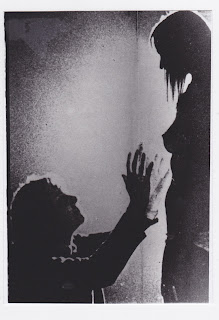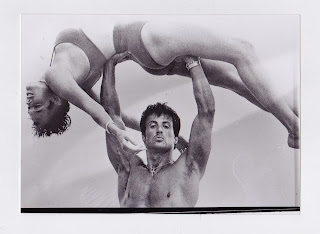Thursday, 31 January 2013
Friday, 25 January 2013
Sunday, 20 January 2013
Finding Images
I decided I wanted to used found photography for my work. I chose to look for negatives as I liked the idea of not knowing what I was getting until properly enlarging in the darkroom. I decided to look on a bidding website - ebay. I had no idea what I would find or even if anyone would be selling of photographs at all. It was quite hard to find a set of negatives that had no description and were not extremely expensive but in the end I ordered some old-looking black and which 35mm. I liked the excitement of having no idea what was on them, although ultimately I was taking a risk as they could have been awful quality, over exposed, under exposed or completely blank. However when I opened them I found out I had purchased what seemed to be film stills from A Clockwork Orange. I enlarged some of the images and soon will be looking into how I can present them in a way to completely take them out of set their context.


Thursday, 17 January 2013
Vernacular and Found Photography
Vernacular photography is a term used to describe images normally taken by amateur or unknown photographers of everyday life including snapshots, family portraits, holiday photographs ect. However Vernacular photography has now started to integrate vastly into the public eye in new art forms. Photographers such as Joachim Schmid have used different ways of gathering an archive of found photographs and re-presenting them as their own work or, in his own words, "I'm using photographic garbage and turning it into art". This notion came about after artists started insisting there are already too many photographs in the world and there is less of a need to create more. When collecting found images like these however we take away the traditional notion of 'authorship'. Like many of these photographers do, when collection images from places such as a flee market they have just the bare material of the image to work with; there is no sign of a typical 'author' nor any information of the subject.
This leaves us as viewers to construct our own narratives without the constraint of having a fixed knowledge of the photographer, in other words it is open to any kind of interpretation, where as the majority oh artists normally hold an intention behind their work. This also highlights the power that these kinds of images that surround us in everyday life, even without a context we can now view them as 'art'.
It is said that Vernacular photography holds honesty and purity that other forms of photography now lack. In this case we can compare it photojournalism, which is meant to portray and share truth yet it seems to be very structured and in some cases staged. Where as found photography that has documented something in the past as, for example, a snap shot has no intention of being in the public eye, therefore no intention of lying or being mis-leading.
Recently Vernacular and Found photography has grown in popularity and has become somewhat of a 'trend' in the art world and is starting to overtake visual culture. This may be because as 'authored' photography is seems to be controlled by sales, galleries and collectors, 'found photography' somewhat defies commercialisation by having the recycled and historic effect.
Evidence of this can also be seen now in print. In 1994 a magazine was published named FOUND. It is a collection of donated submissions by its readers. It not only includes images but also personal belongings such as love letters, birthday cards, tickets, poetry ect. Another magazine similar to FOUND is Useful Photography, published later in the 90's it includes not only Vernacular images but photographs from print, catalogues, porn, and in general most forms of photography. There are now also websites available that have large catalogues of found images, some which pre-date 1950s. These sights include: http://look-at-me.tumblr.com http://timetales.ddfp.nl/index.htm http://www.objectnotfound.net/photos .
The interesting question that found photography raises is: Who does know what lies beyond the images? This brings us to the ethics of found photography. When you are reproducing existing images there is always a question of copy right and ownership issues. This is similar to found photography, where in some cases when unknown photographers have sold bundles of their old family photos they have given up the right of ownership however there is an ethical issue of privacy involved. Is it disrespectful to publish a persons private life without their knowledge? In some cases where the photographer has come forward a disclaimer is issued however if the photographer remains unaware is it irresponsibly invading into their privacy? This is one of the reasons Joachim Schmid founded the 'Institute for the reprocessing of old photographs' where owners would donate their images, knowing what they would be used for.
When first creating this institute Schmid advertised his scheme by telling people "the chemicals contained in all photographs pose enormous dangers to our health. What‘s more, photographs in such quantities increase visual pollution and undermine our thinking power" while he may be exaggerating a little when it comes to "damaging our health", I do agree with his point that we should start recycling more photographs when we can.
Subscribe to:
Comments (Atom)


